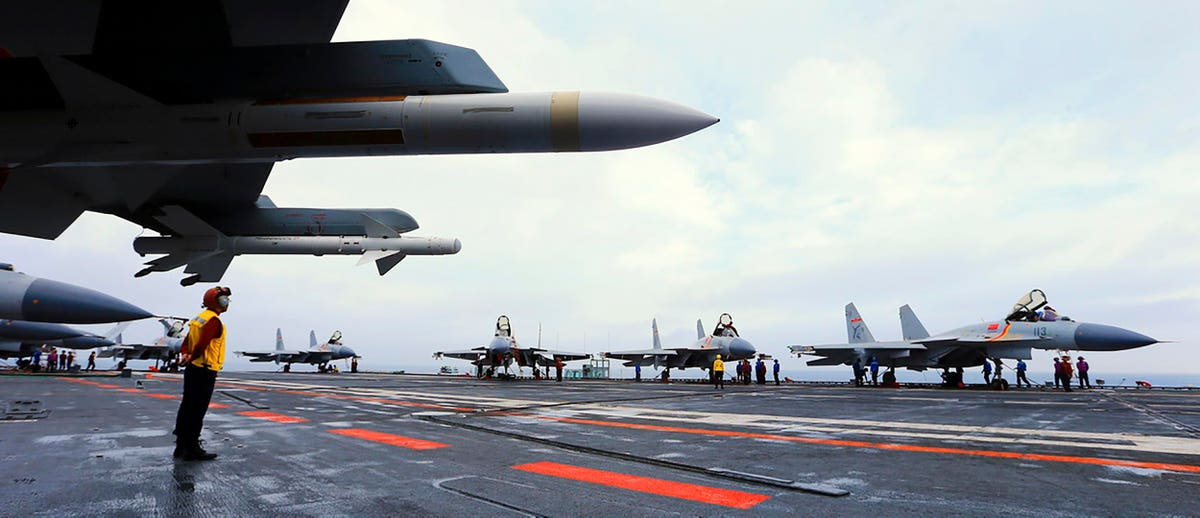You’re probably unaware that most Chinese fighter pilots don’t have college degrees. But with its third aircraft carrier coming online, China is seeking more educated pilot candidates.
Last week, Reuters reported that the People’s Liberation Army Navy (PLAN) placed an advert on social media platform, WeChat, looking for graduate students younger than 26 with master’s degrees in science and engineering to pilot aircraft from ships.
That’s a major change in policy for recruiting fighter pilot candidates in China. Until 2021, the Chinese navy’s fighter pilot candidate recruitment was limited to high school graduates age 20 and younger.
Last year, the service permitted college undergraduates aged 24 or below to apply as pilot candidates for the first time. Earlier this year, the PLAN announced it would accept graduates from non-military colleges to be naval aviators.
The change in policy bucks not only long-established recruitment standards but, as Reuters noted, broader mores in Chinese society which has traditionally regarded military careers as professional paths for the less educated.
But the PLAN will make its third aircraft carrier – CNS Fujian – operational in a year or so following upcoming sea trials. The fighters it will embark with, Shenyang J-15s, are Chinese-built multi-role aircraft modeled heavily on Russia’s Sukhoi Su-33 carrier-borne fighter.
Nicknamed the “Flying Shark”, the J-15 debuted on China’s first aircraft carrier, CNS Liaoning in 2014. Roughly equivalent to fourth generation U.S. Navy fighters like the F/A-18E Super Hornet Block I, the J-15 reportedly received avionics upgrades in 2022, possibly including a new advanced electronically scanned array (AESA) radar, an infrared search and track (IRST) system, new secure datalinks and an advanced electronic warfare suite.
Along with new air-to-air and air-to-surface missiles, the J-15’s collection of systems requires sophisticated technical acumen and systems management skill approaching that which Western carrier pilots require.
USNI News observed that PLAN fighter pilot production has been hampered by the lack of a dedicated two-seat trainer version of the J-15. “The JL-9G trainer is much lighter and slower than the J-15 and thus unable to replicate the J-15’s handling. Trainee pilots soloing on the J-15 also lack an instructor in the back to coach and provide guidance.”
Without qualified instructors accompanying students in the trainer, PLAN fighter training leadership may feel that better educated pilot-students stand a better chance of soloing more quickly and adapting to the J-15.
Better educated pilot candidates might also be more capable of absorbing and learning Western fighter tactics that China has striven to expose them to via recruitment of NATO trained fighter pilots including ex-RCAF Canadian pilots recently revealed to be working in China.
Matthew Funaiole, senior fellow at the Center for Strategic and International Studies (CSIS) China Power Project, says the PLAN’s bump-up in pilot candidate standards is no surprise.
“It’s not unexpected that China would seek highly-qualified college graduates as it develops its naval aviation capabilities, which importantly remain nascent. These are also prestigious posts, and China graduates large numbers of students every year, so there is a large pool of potential candidates.”
Broadening that pool may also be a response to the sort of military recruitment challenges that America is all too familiar with. USNI News noted that last year’s call for graduates from non-military colleges at ages up to 24 “indicates there is still a shortfall of candidates suitable for naval aviation training.”
The flip-side of the changes in pilot candidate acceptance policy is a reminder that that most PLAN and PLAAF (People’s Liberation Army Air Force) are not college graduates. Instead, they have gone through training in China’s long-established flight academy system which today has been consolidated into three institutions; the Harbin Flight Academy, the Shijiazhuang Flight Academy, and the Xi’an Flight Academy.
Pilot candidates as young as 16 have entered this system, beginning officer training first, followed by basic, intermediate and advanced flight training. The training system has undergone a major revamp in the past decade and even more in the past five years as detailed in a study by Australia’s China Aerospace Studies Institute.
Among the doctrinal changes it calls out is a more independent approach to pilot candidate training and thinking, breaking with the traditional ground-controlled, scripted operations and tactics approaches of the past. This new approach is likely another factor driving the criterion for more educated pilot candidates with degrees.
The requirements may also reflect a desire for more mature operational pilots given the tension around Taiwan and recent close-call incidents with American aircraft. As an article in The EurAsian Times pointed out early this year, the PLAAF’s use of young fighter pilots fresh out of its training academies to patrol off China’s southeast coast across the water from Taiwan has created dangerous, potentially escalatory intercepts by inexperienced pilots.
Given that PLAN pilots are operating from aircraft carriers even closer to sensitive geopolitical areas, a dose of the maturity and critical thinking skills that older, university-educated pilot candidates might possess may be highly desired by PLAN Air Wing leaders.
The acceptance parameters are a signal that China is trying to professionalize and improve its military as the U.S. lets its own military sink in terms of capacity, capability and unity.
Read the full article here





